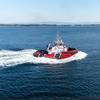In the last six months, the shipping industry has seen the marine B2B market grow from nothing into a highly competitive race between e-commerce ventures to attract major shipowner/shipmanager support and investment capital.
The advent of E-commerce in shipping
The shipping world has suddenly come alive to the world of e-commerce. Within the last few months, the industry has grown from a few providers of marine e-commerce Internet services to more than 70 e-commerce portals targeting different market segments - and more portals and initiatives are launched every day. Shipping companies are now recognizing that e-commerce is no longer a 'nice-to-have' option. For shipping companies battered by poor annual earnings, embracing information and communication technology may not be a matter of choice, but a matter of survival. Shipping companies that are eager to trade for products and services on the Internet can expect significant savings. Companies already involved in e-commerce are estimating savings of up to 50 -70 percent on transaction costs, and as much as 20 to 35 percent on the cost of the goods supplied. For this reason, many believe that maritime related e-commerce could develop into an industry with a multi-billion dollar turnover. With stakes so high, it is no wonder that the battle for dominance in this previously untapped market is fierce - and the willingness to invest significant.
Dot.com investments and destiny
Investment in marine e-commerce ventures has been increasing rapidly. Whether from direct investment from shipowners, or capital raised by IPOs , each marine e-commerce portal requires some $10 to $25 million in start-up costs, and some companies will have to spend much more.
According to industry analysts, more than $250 million has already been committed. If such levels of investment are raised by each of the 70 companies active in this market, the figure could rise to $1.25 billion for an intermediary process. This high barrier to entry will result in the failure of a significant number of e-commerce portals. Few, if any, of these portals are making real money today. We believe that suppliers and advertising media will be the winners of the initial phase of e-commerce in shipping - the business logic pursued by these e-commerce ventures today is a typical phase of "dot.com" evolution. "Few, if any, of these portals are making real money" Over the next 12 -18 months, a large number of companies offering e-commerce portals will fail. Some may lack enough capital, others may struggle with the technology, while still others may fail to win market support. Those that succeed will merge with other successful ventures, while those that fail will lose personnel at a fantastic rate. In fact, according to one study, the average employment tenure in a San Francisco dot.com company is about 13 months.
Portals for everyone?
Not all shipping companies and suppliers can operate their own portals and realize huge returns. The larger operators have the advantage of commanding industry recognition and can "force" their suppliers to use their portals -- but will that get them to where they want to be? Now that most of the hot air has been taken out of the dot-com bubble, it may be time for e-commerce players to rethink their strategy as investors and operators.
Shipping companies wishing to capitalize on the new economy must be willing to take a collaborative approach to developing the business. Their interests as investors with companies like V-ships, Frontline, OMI, Stena, P&O Nedlloyd and Stolt Nielsen, may actually work to delay the realization of the process and cost benefits that the industry so badly needs. In building parallel infrastructures and backing various portals and standards, they are betting on backing a winner as an investor, but not necessarily helping bring about real savings.
New economy logic
The size of the trading community is ultimately a determining factor in assessing the value of the network in the global economy. The winners in the e-commerce and portal race must be capable of combining branding and marketing, technology and transactions, distribution, cash management and risk management together with maintaining a viable (and changing) strategy, clear vision, deep pockets, and most important, the ability to execute the market winning combination. Getting the technology right is crucial. There are still some that believe that an e-commerce portal is an internet site. The industry is learning quickly that integrating e-commerce ventures with back office systems is the only way for e-commerce to gain full acceptance. Let's face it, you can sign up all the purchasers and suppliers you like, but if they don't like using your web-site then you probably are not going to generate much revenue. Success will come from seamless integration with the ship and office purchasing systems and the suppliers sales order systems. In short, it's OK for a vendor to type in quotations into a browser, but a purchaser wants to have his purchase requests processed directly from the system that he already has.
"Let's face it, you can sign up all the purchasers and suppliers you like but if they don't like using your web-site then you probably are not going to get any revenue" Integration means universal data standards and freedom of competition demands open standards. While some will pursue the line of proprietary systems, history has shown time and time again that technology has gained acceptance and commercial success through open standards. IMPA led the way with the IMPA ETS format. XML has undoubtedly replaced EDIFACT and XML is now becoming the accepted format. But XML itself is not a precise standard - a marine definition is required and the new IMPA standard is IMPA MTML, which has already been accepted by a number of e-commerce portals. However, it is likely that we will see a family of standards instead of a universal standard. Many owners have already invested heavily in infrastructures and systems, and it is unlikely that a company that recently went on-line with176 key suppliers by way of EDI would drop everything and make the switch to a universal standard. "We cannot see the company who just got online with its 176 key suppliers by way of EDI switch to a universal standard"
Self fulfilling prophecy
Ship operators do not want to search 56 web-sites to place an order and no supplier wants to search the same 56 web-sites to offer a bid. Indeed the very premise of maintaining a multitude of options will help keep people and costs inside the process. Therefore, rationalization of the shipping e-commerce community is needed to realize the industry benefits that e-commerce can deliver.
"Rationalization of the shipping e-commerce community is needed to realize the industry benefits that e-commerce is set up to deliver" Because back office systems integration is key to costs-effective e-commerce, shipowners and shipmanagers will most likely choose one portal to be efficient. So, while today we are seeing a certain element of specialization, purchasing, bunkers, cargo bookings, logistics etc., there will be both technical and commercial drivers for these services to amalgamate into a unified service provider through a single portal. In short, the niche player will be squeezed out. It is inevitable that of the 70 Internet portals operating today perhaps five will survive. Today's marine procurement e-commerce ventures are in a sudden-death, winner-take all game of Darwinian evolution. There will be room for niche players, but as in most mature industries (excluding shipping) the majority of trading will be conducted with only a few players. (In commerce we see Wal Mart/Tesco/Carrefour dominating, for car manufacturing we see Crysler/Ford/GM, etc.) We expect that in 3 years time that 3-5 "super-portals" -- offering the full range services -- will emerge to dominate the market.
By Paul Ashton (SpecTec UK) and Thomas Falck (SpecTec Group)
Sponsored Content
Safer Starts Here: Build Ships, Protect Crews

July 2025
 Read the Magazine
Read the Magazine

 Read the Magazine
Read the Magazine
This issue sponsored by:

Rising Shipyard Stars: Ashley Cordiale's Journey from the Sea to Estimator at Detyens
Subscribe for
Maritime Reporter E-News
Maritime Reporter E-News is the maritime industry's largest circulation and most authoritative ENews Service, delivered to your Email five times per week







